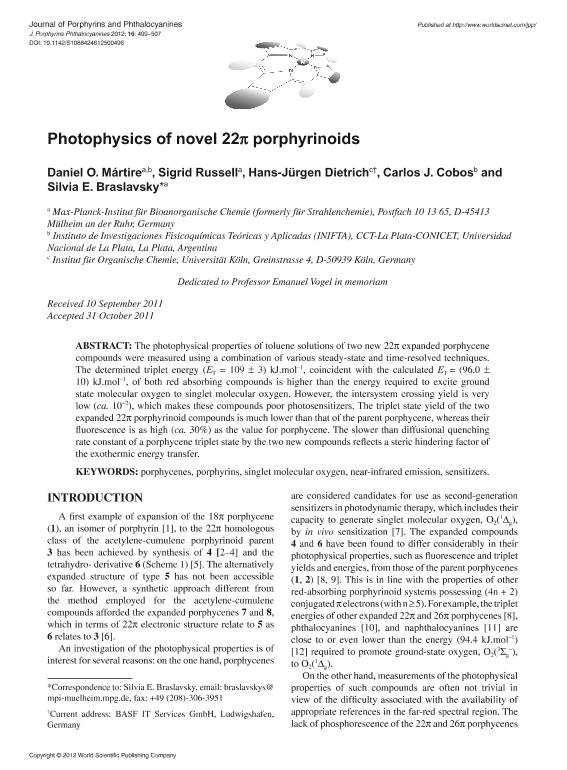Artículo
Photophysics of novel 22 pi porphyrinoids.
Martire, Daniel Osvaldo; Russell, Sigrid; Dietrich, Hans Jürgen; Cobos, Carlos Jorge ; Braslavsky, Silvia E.
; Braslavsky, Silvia E.
 ; Braslavsky, Silvia E.
; Braslavsky, Silvia E.
Fecha de publicación:
01/2012
Editorial:
World Sci Publ Co Inc
Revista:
Journal Of Porphyrins And Phthalocyanines
ISSN:
1088-4246
Idioma:
Inglés
Tipo de recurso:
Artículo publicado
Clasificación temática:
Resumen
The photophysical properties of toluene solutions of two new 22! expanded porphycene compounds were measured using a combination of various steady-state and time-resolved techniques. The determined triplet energy (ET = 109 ± 3) kJ.mol–1, coincident with the calculated ET = (96.0 ±! expanded porphycene compounds were measured using a combination of various steady-state and time-resolved techniques. The determined triplet energy (ET = 109 ± 3) kJ.mol–1, coincident with the calculated ET = (96.0 ±ET = 109 ± 3) kJ.mol–1, coincident with the calculated ET = (96.0 ± 10) kJ.mol–1, of both red absorbing compounds is higher than the energy required to excite ground state molecular oxygen to singlet molecular oxygen. However, the intersystem crossing yield is very low (ca. 10−2), which makes these compounds poor photosensitizers. The triplet state yield of the two expanded 22! porphyrinoid compounds is much lower than that of the parent porphycene, whereas their fluorescence is as high (ca. 30%) as the value for porphycene. The slower than diffusional quenching rate constant of a porphycene triplet state by the two new compounds reflects a steric hindering factor of the exothermic energy transfer.–1, of both red absorbing compounds is higher than the energy required to excite ground state molecular oxygen to singlet molecular oxygen. However, the intersystem crossing yield is very low (ca. 10−2), which makes these compounds poor photosensitizers. The triplet state yield of the two expanded 22! porphyrinoid compounds is much lower than that of the parent porphycene, whereas their fluorescence is as high (ca. 30%) as the value for porphycene. The slower than diffusional quenching rate constant of a porphycene triplet state by the two new compounds reflects a steric hindering factor of the exothermic energy transfer.ca. 10−2), which makes these compounds poor photosensitizers. The triplet state yield of the two expanded 22! porphyrinoid compounds is much lower than that of the parent porphycene, whereas their fluorescence is as high (ca. 30%) as the value for porphycene. The slower than diffusional quenching rate constant of a porphycene triplet state by the two new compounds reflects a steric hindering factor of the exothermic energy transfer.! porphyrinoid compounds is much lower than that of the parent porphycene, whereas their fluorescence is as high (ca. 30%) as the value for porphycene. The slower than diffusional quenching rate constant of a porphycene triplet state by the two new compounds reflects a steric hindering factor of the exothermic energy transfer.ca. 30%) as the value for porphycene. The slower than diffusional quenching rate constant of a porphycene triplet state by the two new compounds reflects a steric hindering factor of the exothermic energy transfer.
Palabras clave:
Porphycenes
,
Porphyrins
,
Singlet Molecular Oxygen
,
Near-Infrared Emission
Archivos asociados
Licencia
Identificadores
Colecciones
Articulos(INIFTA)
Articulos de INST.DE INV.FISICOQUIMICAS TEORICAS Y APLIC.
Articulos de INST.DE INV.FISICOQUIMICAS TEORICAS Y APLIC.
Citación
Martire, Daniel Osvaldo; Russell, Sigrid; Dietrich, Hans Jürgen; Cobos, Carlos Jorge; Braslavsky, Silvia E.; Photophysics of novel 22 pi porphyrinoids.; World Sci Publ Co Inc; Journal Of Porphyrins And Phthalocyanines; 16; 1-2012; 499-507
Compartir
Altmétricas



